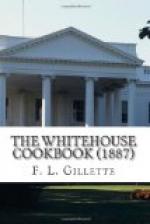In making custard puddings (puddings made with eggs and milk), the yolks of the eggs and sugar should be thoroughly beaten together before any of the milk or seasoning is added, and the beaten whites of eggs last.
In making puddings of bread, rice, sago, tapioca, etc., the eggs should be beaten very light, and mixed with a portion of the milk, before adding them to the other ingredients. If the eggs are mixed with the milk, without having been thus beaten, the milk will be absorbed by the bread, rice, sago, tapioca, etc., without rendering them light.
The freshness of all pudding ingredients is of much importance, as one bad article will taint the whole mixture.
When the freshness of eggs is doubtful, break each one separately in a cup before mixing them all together. Should there be a bad one amongst them, it can be thrown away; whereas, if mixed with the good ones, the entire quantity would be spoiled. The yolks and whites beaten separately make the articles they are put into much lighter.
Raisins and dried fruit for puddings should be carefully picked and, in many cases, stoned. Currants should be well washed, pressed in a cloth and placed on a dish before the fire to get thoroughly dry; they should be then picked carefully over, and every piece of grit or stone removed from amongst them. To plump them, some cooks pour boiling water over them and then dry them before the fire.
[Illustration: STATE DINING ROOM.]
[Illustration: THE BLUE ROOM.]
Many baked pudding recipes are quite as good boiled. As a safe rule boil the pudding twice as long as you would bake it; and remember that a boiling pudding should never be touched after it is once put on the stove; a jar of the kettle destroys the lightness of the pudding. If the water boils down and more must be added, it must be done so carefully that the mold will not hit the side of the kettle, and it must not be allowed to stop boiling for an instant.
Batter should never-stick to the knife when it is sent to the table; it will do this both when less than sufficient number of eggs is mixed with it and when it is not cooked enough; about four eggs to the half pound of flour will make it firm enough to cut smoothly.
When baked or boiled puddings are sufficiently solid, turn them out of the dish they were baked in, bottom uppermost and strew over them finely sifted sugar.
When pastry or baked puddings are not done through, and yet the outside is sufficiently brown, cover them over with a piece of white paper until thoroughly cooked; this prevents them from getting burnt.
TO CLEAN CURRANTS.
Put them in a sieve or colander and sprinkle them thickly with flour; rub them well until they are separated, and the flour, grit and fine stems have passed through the strainer. Place the strainer and currants in a pan of water and wash thoroughly; then lift the strainer and currants together, and change the water until it is clear. Dry the currants between clean towels. It hardens them to dry in an oven.




